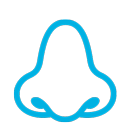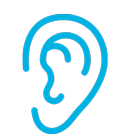Health Measures
Research shows that as one gets older, our senses change. This change is usually a natural part of aging and varies among individuals. To understand more about the sensory function of adults as they get older, we asked NSHAP participants to complete smell, sight, taste, and touch measures during this round of data collection.
The measures collected in NSHAP have been previously validated for use in survey studies by NORC at the University of Chicago and other research institutions. If you are interested in learning more about the NSHAP study and measurement protocols, go to www.norc.uchicago.edu/nshap.
Learn more about the sensory activities you completed and how individual scores were calculated.

Olfaction (smell)
We measured smell by having participants identify the different odors of five smell pens.
The score listed on your results handout is the number of odors you identified correctly.

Vision acuity (sight)
We asked participants to read lines off of a vision chart while sitting about 10 feet away, while wearing their glasses or contacts.
Your vision score was calculated based on the smallest line you could see clearly and read accurately.

Gustation (taste)
We asked participants to identify the taste of four paper strips.
The score listed in your handout is how many strips you identified correctly.

Hearing
We did not test participants’ sense of hearing. However, will be asking NSHAP participants to take the National Hearing Test in the future to learn about all five senses.

Touch
We tested the sense of touch by having a volunteer “helper” touch the fingertips of participants with three touch wands while they had their eyes closed.
The score listed in your handout is the number of correct responses during this measure.
We are not able to provide national results for the sense of touch at this time. We hope that the data collected through NSHAP can help us provide this type of information in the future.
Blood Pressure
To understand more about the blood pressure of NSHAP participants, we asked you to measure your own blood pressure and tell us your numbers.
Blood pressure measures how hard the blood is pushing against the walls of the arteries. Systolic blood pressure is the pressure caused by your heart contracting and pushing out blood. Diastolic blood pressure is the pressure when your heart relaxes and fills with blood.
The table below shows the blood pressure categories recognized by the American Heart Association.
| CATEGORY | SYSTOLIC | DIASTOLIC | |
|---|---|---|---|
| Normal | Less than 120 | and | Less than 80 |
| Elevated | 120-129 | and | Less than 80 |
| High (Stage 1) | 130-139 | or | 80-90 |
| High (Stage 2) | 140 or higher | or | 90 or higher |
| Hypertensive Crisis (consult a doctor immediately) | Higher than 180 | and/or | Higher than 120 |
Body Mass Index (BMI)
To calculate your BMI, we have used the weight you reported this year and height we recorded for you during our visit in the 2015-2016 round of data collection.
BMI is a simple way to figure out one’s level of body fat and weight category. BMI is calculated by dividing a person’s weight and height.
The National Heart and Blood Institute recognizes the following BMI and weight categories:
| BMI | WEIGHT CATEGORY |
|---|---|
| Less than 18.5 | Underweight |
| 18.5-24.9 | Normal |
| 25.0-29.9 | Overweight |
| 30 and higher | Obese |
For reliable health information about various health topics related to aging visit the National Institute on Aging (NIA) website at https://www.nia.nih.gov/health. You can order free print publications or sign up to receive updates and resources delivered to your inbox.
